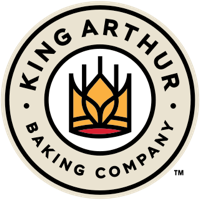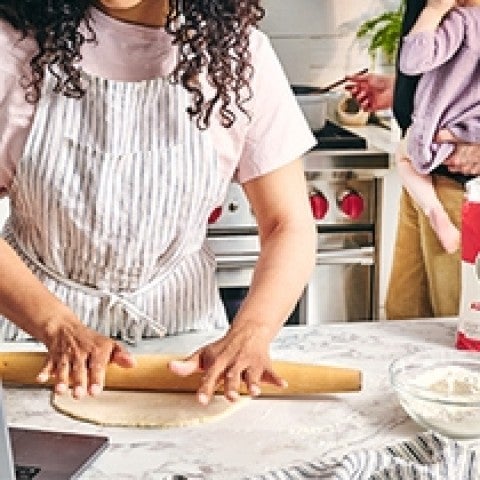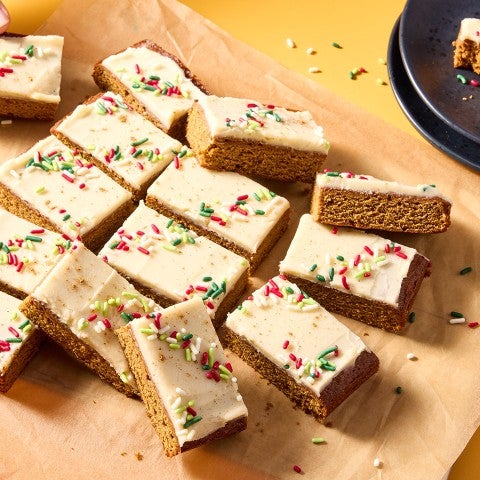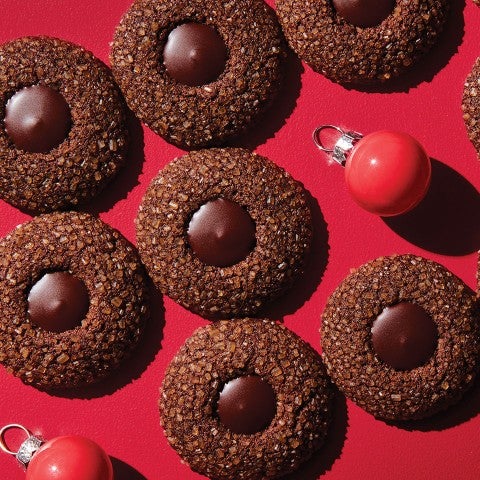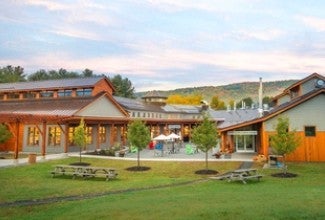History in the baking: talking biscuits with Deb Freeman
We’re closing out our first season with a complex, fascinating, and all-around delicious baked good: biscuits!
Historian and food anthropologist Deb Freeman is here to teach us about biscuits’ riveting history, discussing their early role in American baking and the way Black bakers’ skill and knowledge have contributed to where biscuits are today. Then, Jessica and David answer your biscuit baking questions in Ask the Bakers, covering everything from the best flour to use for biscuits (with a cameo from our Research & Development kitchen!) and how to pick the right butter. Our producer Rossi Anastopoulo joins the show to share the surprising link between biscuits and basketball in North Carolina, and David and Jessica close out the episode with a Jess-opinion all about biscuits at breakfast and the best recipes they’re baking this week.
Recipes and other links from this episode:
- Follow Deb on Instagram and watch her PBS series, Finding Edna Lewis
- Read Deb’s piece The rise: a history of American biscuits
- Read Vonnie Williams’ piece Erika Council’s tips for better biscuits
- Find our new Buttermilk Biscuit Flour Blend
- Buttermilk Biscuits recipe
- What David’s baking this week: Braided Challah recipe
- What Jessica’s baking the week: Old-Fashioned Cake Doughnuts recipe
- Record your question for our Ask the Bakers segment here!
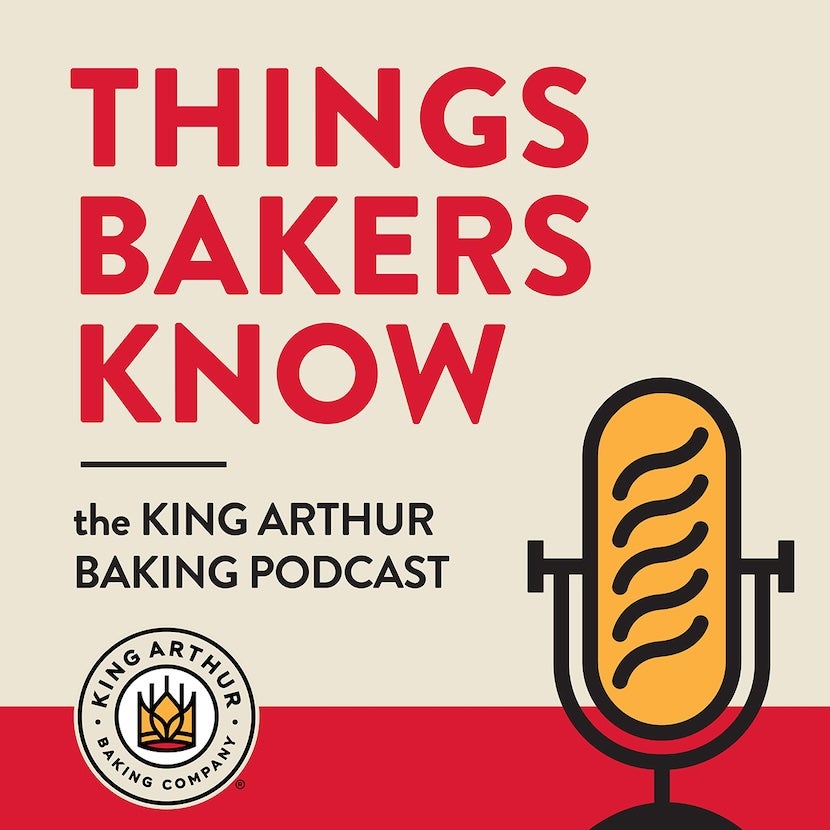
Episode Transcript
Jessica: You know, and they do rise in the oven, but like they're not, you know, miracle workers. They can't —
David: You're like, why'd my biscuits come out so thin? Because we put 'em in thin baby.
Music in
From King Arthur Baking Company. This is Things Bakers Know. I'm David Tamarin, King Arthur's Editorial Director.
Jessica: And I'm Jessica Battilana, Staff Editor at King Arthur Baking.
David: Today we're talking about one of the original American baked goods, biscuits.
Jessica: Man, I had a biscuit for breakfast this morning just to get ready for this episode.
David: You were training?
Jessica: I was training, yeah. I'm always in training.
David: That's the training plan I need to be on.
Jessica: I'm glad that we're talking about biscuits because I think they're a baked good that seems quite simple. You know, they have a short ingredient list.
You see them all over the place. Like they're sold in canisters in the grocery store, at fast food chains, at higher end bakeries. But sort of underneath the craggy, flaky, golden crust, and you know, between all those layers, biscuits are actually a pretty complicated and fascinating bake, and I don't mean complicated in technique, although that too, and we'll talk about that later in the episode.
But also, they're one of the most foundational baked goods in America. I mean, really, you could argue they're one of America's like first baked goods. And the history of biscuits is particularly intertwined with the skill, knowledge, and contributions of Black bakers in American history, and that's something we're gonna be talking about later in the episode.
You know, biscuits inspire, as we have discovered in talking about this, a lot of passion. There's so many different styles of biscuits.
David: Yep.
Jessica: They're deeply rooted in regional preferences.
David: Mm-hmm.
Jessica: I mean, I feel like maybe we're sort of being posers 'cause we're here. We are two, you know, New Englanders talking about biscuits.
David: Wait, excuse you. I am from Ohio. I am Midwestern to my core, but I was thinking yes. Yeah, here we are, a Midwesterner and a New Englander talking about biscuits. But we do have some Southerners coming in later. A couple Southerners.
Jessica: I mean, and there are examples of biscuits. You know, here in my home state of Maine, they're the Bakewell biscuits, but then elsewhere you find like the giant cathead biscuits of the South.
I just love the name of those, like so named because they're as large as a cat's head, which is such an amazing visual and you know, in every style between, from fluffy to flaky to craggy to soft and tender. So there's actually a lot to unpack, you know, even in something as seemingly simple as biscuits. Food and travel writer Vonnie Williams wrote a wonderful piece for King Arthur about Atlanta baker Erika Council's biscuits, which we'll link to in the show notes. And she quoted Erika saying biscuits are the people's food. Which I think really captures the way that they resonate with people sort of across the spectrum, across the country. And even though the biscuits are steeped in history, I feel like they're still as relevant, you know, in today's baking landscape as they have ever been.
So I'm excited to dig into this one today.
David: I love that quote. Biscuits are the people's food. It's so true, and it's true, Jessica, biscuits are still popping. You know, there's, they're all over the place. Everywhere I look, I feel like I've seen a new biscuit. Here where I live in upper Manhattan, there's a Harlem Biscuit Company, which is lines out the door every day. Over at Bon Appetit, our friend Shilpa, amazing baker at Bon Appetit, came out with a recipe for garlic bread biscuits, which I thought was such a fun play, uh, for Thanksgiving. And there's been a big focus on Southern baking, both modern Southern baking and historical Southern baking in cookbooks in the past few years.
One of my favorites is by Cheryl Day, a friend of the podcast. And another one is by chef Kelly Fields and they put a biscuit, a buttermilk biscuit on a pedestal, literally on a pedestal on the cover of their book, just to show like how important this baked is to the South, but also to America as a whole.
Jessica: There are lots of styles of biscuits and I'm just sort of curious like what your biscuit style of choice is right now.
David: You wanna know what my biscuit vibe is?
Jessica: Yeah, I do. And then I feel like we can do some sort of personality test, like what your biscuit style says about you.
David: Okay, great.
Yeah, I, I, I have a vibe and I'll tell you something. I have evolved, I'm like a butterfly. I'm like a biscuit butterfly. I came outta my cocoon and here we go. This is my biscuit truth. I am a fluffy biscuit. I'm a soft biscuit. I don't wanna hear it. I know people want the flaky biscuit. They want like the crispy edges on their biscuit.
Give me a fluffy biscuit. Give me tall, give me soft edges. Make my biscuits baked together in a pan. Let me pull them apart. Let my biscuit kind of be like a roll almost, but better. Like a, like a, just a heartier roll. I just think a fluffy biscuit is where I am. And I'll tell you something else, Jessica.
I am not right now at this very moment. I'm not a savory biscuit. I'm a sweet biscuit. So I want to be spread, like spread me with clotted cream and jam, I guess that's more scone, spread meat with butter and jam. Slather me in honey. I don't know. I was gonna say, put chocolate on. Don't put chocolate on me. I'm a biscuit.
Jessica: I think you're not alone in this. I, I feel like the, the world, okay, I mean, this is to put it in a sort of binary, but I do think there's a big split between people that prefer the sort of fluffy style biscuit. I mean, I feel like I just am making a sport out of disagreeing with you all the time on this podcast, but I —
David: You're good at it too.
Jessica: Yeah, it's, you know, you can't dress up your drive, I guess, but I do like those soft biscuits. But if I'm making biscuits at home, and even if I am gonna buy them at a bakery, I do like the sort of flaky, buttery, crispy edged biscuit. It's like that's a little higher in stature and that has that sort of cragginess, maybe some salt on it or some salted butter.
I read that Dwight Yoakim’s grandmother used to top each one of her biscuits with like a little knob of bacon fat. That seems like a smart thing to me, so I, I actually, you know, I just have a, a, right now, my biscuit vibe is just a little bit different from yours, but I think represents a style of biscuit that's also quite popular.
David: Very popular and very good. I mean, there's no bad biscuit, honestly. I think I, I love any biscuit that you give me.
Jessica: I mean, any fresh biscuit. Let's be clear here. Like whether it's a cream biscuit, a buttermilk biscuit, an all-butter biscuit. All biscuits are good biscuits. But I think where biscuits get really interesting is thinking about the role that they have played in American baking history.
David: One of the ways that I learned about the history of the biscuit was on our own site, we commissioned writer Deborah Freeman, uh, historian and podcaster and food writer to write a story about the history of biscuits, and it was fascinating. Such a good read. And we wanted her to come on the podcast to tell us more and go into maybe some more details that she couldn't fit into the piece, and in particular, the influence of Black bakers on biscuits.
Deb Freeman, welcome to Think Bakers Know, it's a pleasure to have you.
Deb: Thanks so much for having me on.
David: Can you give us a quick introduction for you know, listeners who may not be familiar with you yet, tell us what you do, where you do it.
Deb: Yeah, absolutely. So I am a culinary historian. I focus mostly on black foodways, but also, I, I wite a lot about the South and foods of the South, where they came from, why we eat what we eat. Um, I would stress, I'm not a baker, I'm a historian, but it's one of the things that I love to talk about because I'm from the South, so I'm mandated to, to talk about things like this.
David: To, to talk about biscuits.
Deb: Absolutely.
David: Yes, yes. Uh, you wrote one of the, my favorite pieces of all time on King Arthur's site, a history of biscuits and, and how it came to America. So we're gonna talk a lot about that. Uh, but first, um, you mentioned you grew up in the South and you mentioned in the piece that biscuits were a big part of your upbringing. Uh, can you share your first memory of biscuits?
Deb: Yeah, so my grandmother, who was an amazing cook, basically introduced me to kind of all of my culinary loves, right? And so biscuits was something I would say that wasn't, you know, every day, but was definitely probably every other week kind of concept. But she was making everything from scratch, which I cannot even fathom of today. Uh, doing that love of cooking that often. But basically I remember, you know, getting them out of the pan, she would take a stick of butter and just melt them over the pan of biscuits. And, and hand them to me and they would tell you to be careful because it was hot. So I have a very warm memory of that.
I would also say that that wasn't something that I thought was unique. I thought everyone ate this. I thought this was a common thing, but obviously as I got older and met people from different places, they were like, you're eating biscuits every, what, you what? Where's your bread? I'm like, no, biscuit is bread.
David: In your story for King Arthur, you traced the origins of the American biscuit to ancient Rome. But those early biscuits sound like they were absolutely horrible. Tell us about those.
Deb: When biscuits originally came to be, they were called hardtack. They weren't called biscuits. Um, and they basically were things that sailors could eat and they were supposedly they would last you a really long time. So flour, water, and salt, that's all the ingredients. But they were baked four times and they were made about six months in advance.
David: Oh my god.
Deb: So that they could be incredibly dry and they wouldn't spoil. So I can't even imagine what that tasted like. That sounds insane to me.
David: This was the time before dentists, like how did they even bite those? I mean, they must have been like just like putting them in their mouth and letting them disintegrate. I mean, it just sounds so gross.
Deb: That's why I'm thinking and I just, I feel really bad for Roman soldiers. That just sounds insane.
David: But somehow that biscuit turned into the variety of biscuits that we know and love.
And one thing that you illustrate in your story is that Europeans brought these hard unseasoned biscuits to America. Thank you very much. But then innovation started happening and can you tell us a little bit how that happened?
Deb: Yeah, I mean, I think it's a couple of different things. Initially, it's still pretty similar.
Probably not as hard because you're not waiting for six months to eat it, but they're still not great. Right? But in the South, once you have cows and you have pigs, so you've got buttermilk and you've got lard, and so you're adding that. We don't know exactly who started that, but once you start adding that, then you're getting a flavor profile, right? So that's kind of like the beginning turn of, oh, this might be something that tastes good.
David: You talk about the beaten biscuit, which it seems like that was a pivotal moment in the history of biscuits. What is the beaten biscuit?
Deb: Yeah, so basically early on, again, we're still talking when they're colonies, the beaten biscuit is flatter than we think of biscuits. They're a little more cracker-like. But what's interesting about this is they had a little bit of rise, but the only way to get this rise is to literally beat the dough typically for about an hour. And that task was really given to enslaved women. And so it fell out of favor after the Civil War just because the labor it, it would take.
But I know that it was very popular because there's a cookbook that comes out. Um, Abby Fisher's cookbook, What Mrs. Fisher Knows About Old Southern Cooking, that's one of the first cookbooks that was written by a Black woman. And there's a recipe in that cookbook for these beaten biscuits. So this was pretty common, but after slavery ended, it really fell out of favor just because of the work and the time it took.
David: Okay. So we're at the point in biscuit history where, you know, they're starting to get lighter. This is, I feel like the point where we got lots of contributions from Black chefs and inventors that are pivotal to, you know, making the biscuit what it is today.
Can you talk a little bit about one of them, unless we don't know the person's name, but a Pullman porter. First of all, what is a Pullman porter?
Deb: Yeah, so a Pullman porter were Black men who worked on Pullman trains. They would carry your luggage, they would shine your shoes, they would clean up the trains, and they also cooked for the dining cars.
So that was a job that came about where Black men could work and make a living and also see the country to some extent, but that's a different podcast. Um, but yeah, so that's what a Pullman porter is. And so they were creating these incredible meals in these tiny, tiny kitchens. There's a story that Carl Smith in the 1930s, he was a salesman and he happened to be on one of the Pullman trains headed towards San Francisco, and so he wanted something to eat, but the kitchen was closed, and so he asked one of the Pullman porters to make something for him, and so he was pretty quickly brought out a plate of biscuits.
This guy is like, how did you do that so fast? Because clearly in his mind, you've got to roll the dough, you got to bake it, you've gotta do all of this. And so when he asked that question, the Pullman porter basically explained there was a premixed bowl and it had lard, flour, salt, and baking powder in it. And he kept that on ice on the train.
And so whenever someone asked for biscuits, he just added whatever the wet ingredients were. And so, Carl takes this idea and basically runs with it, and so his company creates a version that could be mass produced, and so this is where we get the kind of ready to bake biscuit mix that you find on your store shelves, you know, even today, that's where that comes from.
David: I love that. But one of my favorite details in your piece is this idea that Northerners had at one point that hot bread was evil. And so they looked down on Southerners who were eating hot biscuits as their bread. They wanted a room temperature, they wanted a cold bread, they wanted a room temperature, a slice of bread, not a hot biscuit.
What were they thinking?
Deb: First of all, that's crazy, right?
David: I think so, yeah. As, as a, as a Northerner, I will say. Yes. Yeah.
Deb: Um, yeah, they thought that, uh, cooler bread was better for digestion. Um, I'm not sure where they got that theory from, but that was the thought. Um, and so they thought that cold, sliced bread, um, that's what good people, I'm using quote fingers for folks, good people ate that. And if you were eating hot bread in the South, the, I believe the word was barbarian. You were barbarian if you were eating that. So, um, I think that's pretty wild.
David: It's so wild. I mean, people, have these people never like in, obviously they never experienced the joy of eating a hot, fresh, you know, biscuit warm. I mean, come on people. OK Deb Freeman, thank you so much. It's been amazing to talk to you about biscuits. Where can people find you?
Deb: Yeah, you can find me on the socials, uh, you can find me on I, uh, under Deb Freeman. And, uh, also, um, you can find me on PBS. I am the exec producer and host of Finding Edna Lewis. Um, and so you'll be able to watch that on PBS too.
David: All right, Deb, thank you so much for being here. It's a pleasure to speak to you.
Deb: Thanks so much for having me. Now I'm hungry.
David: This episode is brought to you by King Arthur's new buttermilk biscuit flour blend. It's made with unbleached soft wheat flour, baking powder, a little bit of salt and real buttermilk.
Jessica: I love that the buttermilk powder is already added to the flour blend because I mean, who keeps a carton of buttermilk on hand for when biscuit emergency strike? Am I right?
David: Totally like, I don't keep buttermilk around because how do you know when it goes bad? It smells like it's off even when it's good. Anyway, you can find our new buttermilk biscuit flour blend on grocery store shelves, which is very exciting. Or of course, at kingarthurbaking.com.
Jessica: It's time for our next segment, Ask The Bakers. For Ask the Bakers, we want to hear from you. If you have a baking question for us, head to king arthurbaking.com/podcast to record a voice message, and we may end up using it on the show. That's kingarthur baking.com/podcast.
David: And of course, if you have a burning baking question that you just can't wait to get answered, you can always reach out to our Baker's Hotline via phone, email, or online chat. Just go to kingarthurbaking.com/bakers-hotline, kingarthurbaking.com/bakers-hotline.
Jessica: You ready for today's biscuit questions?
David: I'm ready. Let's answer them.
Caller: What flour is best used for biscuits?
Jessica: Well, I mean, I think that's one of the most foundational and fundamental questions we could possibly have gotten, right?
David: It's perfect for us.
Jessica: Because like we said earlier, biscuits don't have a lot of ingredients, but flour is one of them. You know, we recently debuted a new product, which is our biscuit flour blend, which was an effort from our Research and Development team. They spent quite a bit of time and many, many biscuits were baked in pursuit of a flour blend that would make the perfect biscuits, and I wanted to just get some insight from one of our R&D pros, Jonathan Brasil, who had this to say about our biscuit flour blend.
Jonathan: We really wanted to make a biscuit flour that allowed for novice bakers to expert biscuit bakers to create perfectly tender fluffy biscuits, even if you make a mistake. Using unbleached, soft wheat flour was paramount to that for that.
Jessica: So I think Jonathan gets really to the heart of the matter here. The best flour for biscuits is a flour that's a lower protein flour. So we've talked about protein level in our flour before. Our all-purpose flour hovers around 11.7% protein, which is great for, as the name suggests, lots and lots of things.
But you know, if you're looking as Jonathan says, for this tender and fluffy biscuit, then what you want is actually a flour that is lower in protein. So rather than a flour that's milled from the hard winter wheat, like our all-purpose flour, this new biscuit flour blend is milled from a softer wheat.
And so you have a lower protein flour, and then when that is formed into a dough, it's just by its very nature going to have less gluten. It'll help with sort of the texture of the biscuit, right? And I think, David, you and I had talked before about just the handling too, right? It's not just the protein and just the dough, but how you mix it.
David: You know, it's not that all-purpose flour is bad for biscuits, it's just that it requires a more gentle touch. If all you have is AP flour and you wanna make biscuits right now, go for it. But just make sure that you're handling that dough really gently, because the more you mess with it, the more gluten you're gonna develop and the less tender your biscuit's gonna be.
That's why the softer wheat is so great for biscuits because you can, you know, don't have to be quite as careful. Let's see what else we've got.
Caller: I have an extremely loaded question about buttermilk biscuits, and specifically the butter. If my goal is a flaky layered, classic buttermilk biscuit, I'm wondering three things.
Number one, if there's a specific brand of butter that you recommend using. Number two, I'm wondering if I should put the butter in the fridge or the freezer to get it extra cold before cutting. And last but not least, I'm wondering what the best way to cut the butter is. If I should be grating the butter, or if I should be cutting the butter into cubes. Let me know. These are life's most important questions.
David: She's not wrong. I mean, these are loaded questions. There's about a million questions in each of these questions and we can answer all of them. So first of all, let's talk about the temperature of the ingredients. When I'm making biscuits, I put everything in the freezer.
I put my metal bowl, I put all my tools in the freezer to get them really cold. And my ingredients too. I don't get them quite frozen. I don't freeze my butter until it's like hard as a rock, but I get it very, very cold. I think that does make a big difference because what you're trying to do here is you're trying to make sure that your biscuit dough, when it goes into the oven, has pockets of butter that will then melt and then release steam.
Jessica: It's kind of like pie dough in that way, right?
David: Yes. Well, and this is if you're making what she's going for, a flaky butter style biscuit. Let's talk about that butter.
She asks for brand. I don't think the brand really matters, but I will say that I like American butter for biscuits, not necessarily European style. Nothing against European style butter. It's delicious. But you know, I asked around. And the King Arthur position on this is save the European butter for the top of your biscuit, for buttering your finished hot biscuit.
American butter has a little more water in it, uh, compared to European butter. And that can be helpful in a biscuit because what you want are those butter pockets to melt, release steam, and then that creates the layers that you're going for. So any good brand of American style butter I think works.
And then she asked a very good question about how to incorporate the butter, which there are many, many methods. You can do it with your hands, you can do it with the pastry cutter. I really like grating. Have you ever tried that?
Jessica: Yeah, I, I like to grate too. And Tandem Bakery here in Portland, the baker there, Brianna Holt, she grates cold butter into cold flour and then she folds. I mean, very much the same process that you would for any sort of pastry that you wanna be like puffing up when it bakes. Those butter questions are great, and again, like the flour questions, you know, what else can you fixate on, right? Like, there's so few ingredients.
So these details actually do matter and I think that people find biscuits to be like, perplexing in the same way that they find pie dough to be perplexing. So I think that we're talking about them together, you know? Makes sense.
David: I think we have one final question.
Caller: Hi. Um, I had a question about biscuits. So every time I make biscuits, they turn out kind of flat, and I was wondering if you could tell me how to make high-rise biscuits or more fluffy style biscuits. Thanks.
David: Again, talk about big biscuit questions. I mean this is —
Jessica: Big biscuit energy.
David: Oh yeah. Big biscuit energy. But yeah, I feel like we're covering all the big questions.
What kind of flour? What kind of butter? And how do I get them high? I think that's what people really want to know.
Jessica: I do think there are some things just in terms of um, technique. That will help no matter what the style of biscuit you're making, that will give you sort of good results. And that is to have a sharp cutter.
If you're using a round cut, whatever, it doesn't matter the shape. Round cutter. Square cutter, but a nice sharp metal cutter. Or if you're cutting them with a knife, I think the same rules apply. You just cut straight down. You know the temptation when you get to the cutting board, after you've cut through the dough is to twist, to sort of release the biscuit.
David: Yeah.
Jessica: And that is what you don't want to do because twisting sort of like seals off the edges of the biscuit dough. So then it's harder for those layers to separate. So cutting straight down and then not messing with it, you're going to get the highest potential rise from the biscuit no matter what style you're making.
David: Yes. Yeah, absolutely. And you know the other tip I would give this caller and everybody is something that I learned from our Baking School and it's one of the best things I've ever learned from our Baking School. Very eye-opening, which is that a biscuit is only gonna rise half of its height in the oven.
So you want to make your biscuits tall before they go into the oven. You wanna make sure that when the biscuits are in dough form that they're tall at that point, because they're not gonna rise that much when they go into the oven. I mean, I think we all have this expectation that biscuits are gonna rise higher than they actually do.
Jessica: That's interesting. You know, and they do rise in the oven, but like, they're not, you know, miracle workers. They can't —
David: they're like, why did my biscuits come out so thin? Because we put 'em in thin baby? Yeah. I don't think there's much risk in making your biscuits higher than the recipe calls for. You will, of course, yield less individual biscuits, and you may need to increase the time they bake a little bit, but you can mess with that if you want, if you're not happy with the height, you know.
Jessica: Yeah.
David: These are great questions.
Jessica: Always good questions, always mediocre answers. No, I'm kidding.
The producer of our podcast, our colleague, Rossi Anastopoulo has been, I mean, she's been haranguing us about sports lately. You know, she and I have had like a lot of conversations about college basketball as of late, and I know that Rossi's a huge fan of the Tar Heels, which doesn't mean anything to me, but means a great deal to her.
And you know, when we were talking about this biscuit episode, Rossi said like, I have a story for you that ties in my love of the Tar Heels and your love of biscuits. And so I told her I didn't wanna get a story in advance. I wanted her to come onto the podcast and tell us the story about the strange union between basketball and biscuits.
Rossi, you're up.
Rossi: So to most people the word biscuits means literally biscuits. Not a surprise. But to me the word biscuits means one thing, and that's basketball. Let me explain here. So I went to the University of North Carolina where basketball is basically a religion.
Jessica: What is that? The Tar Heels.
Rossi: The Tar Heels. Go heels. And so obviously there's like major basketball highlights, like playing Duke our archrival, or playing in the Final Four. One, like very underrated, if you know, you know, moment is biscuit games.
Jessica: Oh, okay.
Rossi: So UNC has a deal with Bojangles, which is obviously the fast food biscuit chain that started in North Carolina.
Jessica: Okay.
Rossi: And this deal started all the way back in 2003, and the catch is if UNC scores over a hundred points in a home basketball game, everyone gets biscuits.
Jessica: Ooh, I like this. Okay.
David: It's the one thing that would get me to a basketball game.
Rossi: And technically it started, everyone got a free biscuit. Now it's two sausage biscuits for a dollar.
But you just treat it like you get free biscuits, but it leads to a really electric atmosphere. So we might be beating a mid-major terrible team by 40 points, total snoozefest. Then as soon as the score gets into the nineties, you just hear people going, we want biscuits. We want biscuits.
Jessica: I love this. That's amazing.
Rossi: And then as soon as someone hits the a hundred point basket, which is known as the biscuit basket, obviously, the crowd goes wild. It's like we've won the national championship. It's just people screaming biscuits at the top of their lungs. And so I'd like to play a biscuit basket for you.
This is UNC up by up by 20 points against one of our rivals NC State. And so we're closing it. It's 99 points. Next score is the biscuit basket.
Video: And if you get points, the fans get biscuits.
David: Never have I seen happier people.
Video: A hundred. Biscuits.
Jessica: I mean, listen to that crowd. The crowd is actually going wild.
Rossi: While we talk about, you know, how important this is to everyone and kind of what it means, I wanna close on a quote from one of the only players to ever hit two biscuit baskets in his career. Jackson Watkins, who hit the shot that we just listened to. So after he hit his second one, he said, “I am the biscuit king. I saw it swish and heard the building explode and let out a roar of my own too. It was excitement, joy, intensity, passion, and just a pinch of surprise.” I think that just says it all.
Jessica: Wow.
David: Mic drop.
Rossi: Next time, next time you go to a basketball game, maybe bring a biscuit in celebration.
David: I, I'm gonna try it every, like I go to my nephew's high school basketball game sometime. I'm just gonna start chanting I want biscuits and see what happens. You know?
Jessica: Rossi I love this story so much. What a great tale.
Rossi: Well, thank you for having me. It was fun to join and to share the story. Thanks guys.
David: Every episode we like to check in with Jessica to see what wildly surprising and full-throated ideas are in her head, a segment we lovingly call Jess-opinions. Jessica, I cannot wait to hear what your Jess-opinion is on biscuits.
Jessica: Well, I mean, I don't know. I, I, I guess the whole point of the segment is that I just tell you what I feel.
David: Yep.
Jessica: From the heart.
David: Yep. I'm your therapist.
Jessica: Which is that. Yes. Uh, it's great.
David: What’s the trend? We listen, but we don't judge. I don't participate in that trend because I judge.
Jessica: I think you might judge but you don't listen. I know a lot of people like a biscuit sandwich, but not me, David, not me.
David: Oh, okay.
Jessica: I don't think that biscuits are the optimal vessel for a breakfast sandwich.
David: Oh, talking about breakfast sandwich. What about fried chicken?
Jessica: Also, I think a little —
David: A chicken biscuit.
Jessica: I think it's a bad choice.
David: Oh, whoa. Okay.
Jessica: Not from a, from a flavor perspective. Not from a flavor perspective.
I mean, I just think it's difficult because what I love so much about biscuits is that they have this tenderness. And so, I mean, how many fried chicken biscuit sandwiches have you eaten that have like held together as you're eating them?
David: Yeah.
Jessica: They like fall apart. The biscuit starts to crumble. Like give me an English muffin.
David: Oh, okay.
Jessica: I mean, I wanna eat a biscuit and I want to eat an egg sandwich, or I wanna eat a biscuit and I wanna eat fried chicken, but I don't need them to be together.
David: Okay.
Jessica: That's just me though, you know?
David: That's just you. So what do you like to put on your biscuits?
Jessica: Butter, and sometimes honey. But that's pretty much it. Jam maybe.
David: The simple life.
Jessica: Just the simple life. I mean, can you beat a warm biscuit split and topped with butter and honey or jam? I mean, that sounds so good.
David: No, I, I don't think you can beat it. And between the two, I'm always gonna go for honey. Honestly. A honey biscuit, to me, a honey biscuit. It's great.
Jessica: Yeah.
David: Anyway, so you're not making biscuit sandwiches this week, but what are you baking, Jessica?
Jessica: Oh, that's a good question. So you know about once a year, I get this bee in my bonnet to make donuts at home.
David: Ugh. Invite me over.
Jessica: I know. It's, uh, it's like a, you know, it's its own holiday, donut day. I don't know. 'cause it's a pain. I mean, fried dough is always good, but fried dough is always a pain to make at home. But a freshly fried cake donut. I prefer cake donuts to yeast donuts. Just another bonus Jess-opinion for you. But you know, fresh from the oil, like a little nutmeg in the dough, where they're sort of craggy. And I don't even roll them in sugar or anything. I just like 'em straight up. So this could be the weekend, this could be cake donut weekend.
I mean, yes, effort, but the reward, high reward, you know? Talk about a way to win friends and influence people.
David: Uh, to have friends. That must be nice. You know? Maybe that's why I don't have any, I never made donuts for them.
Jessica: Yeah. You should start frying donuts. Someday. I'm gonna tell you some, I, there's a apocryphal family story about me getting lost on a snowy mountain in Vermont that ends with donuts. So I'm gonna save that for our donut episode.
David: It's a true story?
Jessica: It's a true story. Yeah.
David: Can't wait.
Jessica: I know, uh, what are you gonna bake this week?
David: Uh, I'm making challah. I'm making the challah from our Big Book of Bread. I think it's a great recipe. I am working on proofing my challah expertly. I think that the hardest part of making challah, the hardest part of making challah is not the braiding, although that can be challenging.
Um, it is in the proofing, it's getting the proof exactly right. Because when you have a perfectly proofed challah, the shape keeps and you having none of that dreaded tearing. I never really cared about tearing in challah before, before I realized that it was a sign of a mistake I'd made. You know? So, uh, so now I really try to avoid that.
Um, but even if I don't get the proof right, I'm going to eat it.
Jessica: Still going to eat, still gonna toast. Yeah. A long mix for that dough, you know, and then I think a long proof, a little bit longer than you think. Probably a little warmer than you think. And do you do just like the three-strand braid? Are you like a four strand, six strand, eight strand?
David: I've, uh, yeah, I do a 28 strand. Um, I do a three strand. I keep it simple. You know, the best tip I ever got, again from King Arthur, uh, about braiding challah, was to start in the middle. That makes a huge difference.
Jessica: Yeah, it does. And we did put that tip in the book because, and why do you start in the middle?
David: If you start at one end, you have, there's more risk of having an uneven shape and also of maybe having like a more of a bulbous end at the one you start with. And then it just kind of becomes more like a V shape than a, than a oval shape.
Jessica: Yeah, it's like the swimmer's body of challah. And then you get those slices at the end that are like so small. In fact, I just had a challah at home last week and I made my son like three of the smallest peanut butter and jelly sandwiches you've ever seen because it was like the end of the loaf. And I was like, well, one is not enough. So yeah, he had like silver dollar peanut butter and jelly challah sandwiches.
David: I wouldn't turn it down.
Jessica: No. Sadly, this actually brings us to the end of our first season of Things Bakers Know. We've had such a good time talking about everything from cookies in space to David's favorite birthday death cakes, and we want to thank all of you for listening.
David: Yes. Thank you for listening to all of our truly random opinions, all of our Jess-opinions, and thanks for all your questions. The questions were amazing. And Jessica, I just wanna thank you too. You know, we have a culture of appreciation here at King Arthur, and I am sending you so much appreciation for being such a great co-host.
Jessica: It was such a good time.
And you know, of course, a thank you to all of our amazing guests who joined us on this first five episode season. I, um, I'm really eager to record more. I've had such a great time doing this, and we will be back with a new batch of episodes when season two debuts this fall. We're gonna cover all sorts of fun things from holiday baking to topics like pie, focaccia, and perhaps my favorite of all, baking with kids. In the meantime send us your baking questions at kingarthurbaking.com/podcast. And you may be featured on a future episode.
David: And please, if you like this podcast, make sure to subscribe. It's the best way to figure out when we're back with new episodes and you never know, we may drop a special episode sometime between now and the next season.
So to do that, go to Apple Podcast, Spotify, Apple Music, or wherever you listen, click that subscribe button. And you'll be notified as soon as any new episode drops. In the meantime, you can always find us over at kingarthurbaking.com. And don't forget, people, please just follow that recipe. Come on.
Jessica: Follow that recipe. See you next season.
David: Things Bakers Know is hosted and executive produced by me, David Tamarkin.
Jessica: And me Jessica Battilana.
David: Rossi Anastopoulo is our senior producer. Chad Chenail is our producer and engineer. Original music by Megan and Marcus Bagala. Special thanks to today's guest, the fabulous Deb Freeman. Deb is the host and executive producer of Finding Edna Lewis.
You can also find Deb online at her website, deb-freeman.com. We'll add a link to Finding Edna Lewis and the article she wrote on King Arthur's website about biscuits in the show notes. Things Bakers Know is a King Arthur Baking Company podcast.
